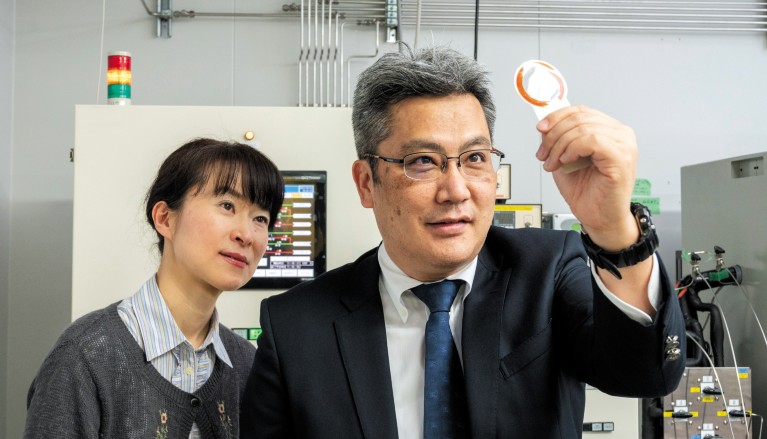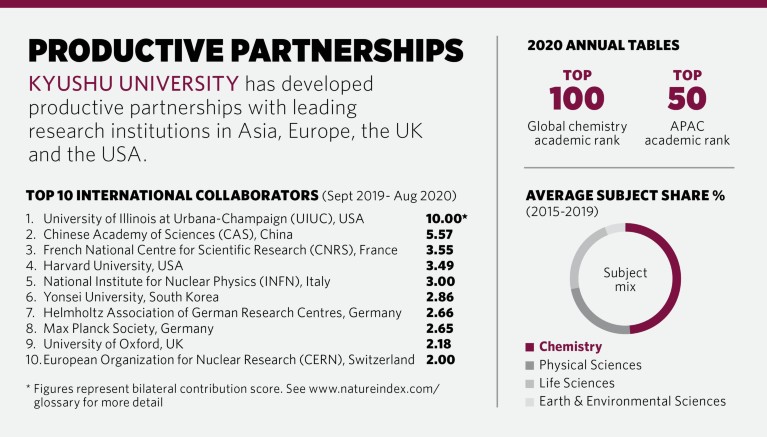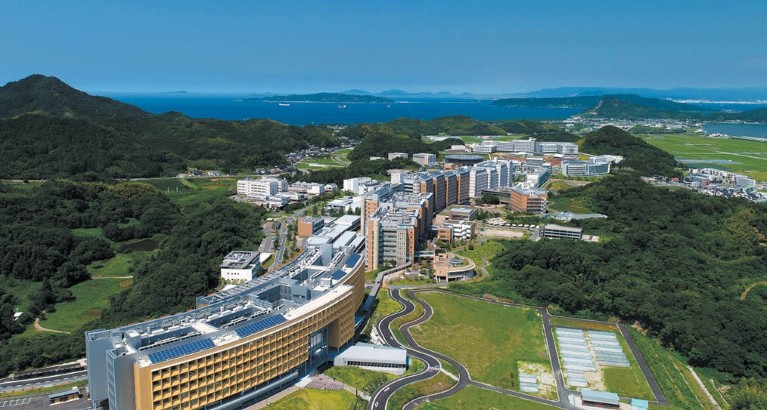The urgent need to directly reduce the amount of carbon dioxide (CO2) in the atmosphere has spurred Professor Shigenori Fujikawa, and a multidisciplinary team of world-class researchers at Kyushu University’s International Institute for Carbon-Neutral Energy Research (I2CNER), to look beyond being ‘carbon neutral’ to a far more ambitious goal of capturing carbon from the air.

An ultra-high-performance analyser is central to refining CO2 capture and conversion technologies.
During the millennia leading up to the industrial revolution of the early 1800s, when humans produced relatively little in the way of CO2 emissions, Earth’s atmospheric CO2 concentration had stayed in a narrow range of 200–300 parts per million (ppm). How quickly that has changed.
From about 280 ppm in 1850, the global atmospheric concentration now sits above 400 ppm — a rise largely attributed to the emission of an estimated 440 billion tonnes of CO2 due to burning of fossil fuels. There is a global push to transition away from fossil fuels or otherwise offset the CO2 that their combustion produces. However, the CO2 already in the atmosphere has likely locked in a significant rise in global temperature that will continue for centuries.
“I2CNER, in its first ten years, had two primary foci: hydrogen-based energy and CO2 capture and sequestration. Funded under Japan’s World Premier International Research Center Initiative, we were advancing fundamental research on carbon-neutral energy technologies with leading researchers from the likes of University of Illinois at Urbana- Champaign, MIT, and Imperial College London,” says Fujikawa.
“At the culmination of that programme in 2020, we made a huge discovery that boosted the potential for targeting carbon capture directly from the air and led us to increase our focus on this novel approach,” says Fujikawa. “Around the same time, the Japanese government announced its Moonshot Research and Development programme, which matched our goal perfectly.”
Japan’s moonshot programme aims to create disruptive innovations by promoting challenging research on revolutionary novel concepts in order to tackle huge issues like climate change and managing Japan’s ageing population. Moonshot funding now supports I2CNER to efficiently capture CO2 directly from the atmosphere using a nanomembrane — an idea previously dismissed as impossible or wildly impractical.

Professor Yamauchi (left) and Professor Fujikawa with the CO2 separation membrane that helped to spark the moonshot project.
“Carbon capture is already performed on industrial scales by absorption into a liquid solution or fixation in a solid, porous material, which is then heated or processed to recover the CO2,” says Fujikawa. “Such systems effectively pull carbon from the air, but the technology they use is very energy intensive and requires large-scale systems to be feasible.”
Directly ‘filtering’ CO2 from ambient air was thought to be impossible, and there was almost no previous research on the idea. “But we didn’t give up,” explains Fujikawa, “and through our research we found that when the filter membrane becomes extremely thin, less than 40 nanometres in our case, the gas permeance jumps to the highest value ever reported at 40,000 GPU (gas permeance unit). That’s the idea we now take to the moonshot project.”
Two factors determine the efficiency of CO2 removal by gas separation membranes — the permeance of the membrane, or how much gas can pass through it, and the selectivity of the membrane for the gas molecules of interest, in this case CO2. Fujikawa’s team have shown that high permeance is possible using a robust ultrathin nanomembrane without pinholes, and they are now working on increasing the selectivity for CO2 as well as developing systems utilising the membranes.
“Our ultimate goal is to create a small modular system that could be installed at any scale for ubiquitous ambient CO2 capture and conversion,” says Fujikawa. “Just like solar panels have decentralised and democratised energy production, we hope to do the same for carbon capture.”
Membrane separation's potential lies in its smaller footprint and simpler setup and operation than other conventional CO2 capture technologies. “We could use existing infrastructure like gas pipelines to transport methane produced from captured CO2 or store the captured CO2 as a carbon resource,” says Fujikawa. “The moonshot includes the challenge of deploying this technology in society, which our team is working on, with a view to a prototype in 2030 and widespread deployment by 2050.”

Drawing on Kyushu University’s broad disciplinary range that includes law, engineering, economics and design, the moonshot team is tackling the concept from all angles: from urban engineering to socio-environmental energy science and the efficient conversion of CO2 to useful products. These efforts will be coordinated through the Research Center for Negative Emission Technology, which is set to launch 1 April 2021.
“We are very excited for the opportunity to pursue research that we hope will change society and the Earth’s climate trajectory by creating a sustainable, decentralised carbon cycle,” Fujikawa says.
Founded in 1911, Kyushu University is one of Japan’s leading research-oriented institutes of higher education. Located in Fukuoka, the university has close to 20,000 students (including over 2,300 international students) and is comprised of 12 undergraduate schools, 18 graduate schools, 16 faculties, 5 research institutes, a university hospital, and over 50 affiliated research centers.

Located in Fukuoka, Kyushu University has great strength in carbon capture research.
Summary of CO2 and climate information from NOAA: https://www.climate.gov/news-features/understanding-climate/ climate-change-atmospheric-carbon-dioxide
For all research outputs for Kyushu University refer to the Nature Index




 Collection: Nature Index 2021 Asia Pacific
Collection: Nature Index 2021 Asia Pacific